The Fall 2022 Preview Guide
Exception
How would you rate episode 1 of
Exception (ONA) ?
Community score: 3.3
What is this?
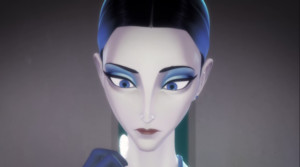
In the far future, humanity has been driven from Earth and forced to move its population to another galaxy. Members of a scouting team are sent to search for a planet suitable for terraforming. The crew is created through a biological 3D printer, but a system malfunction causes one of the crew members, Lewis, to emerge in a deformed state. As Lewis turns on his fellow crew members Nina, Mack, Patty and Oscar, a countdown to the end of the mission begins in the frightening darkness of the ship.
Exception is based on a new story by novelist and film director Hirotaka Adachi with character designs by Final Fantasy's Yoshitaka Amano. It is streaming on Netflix.
How was the first episode?
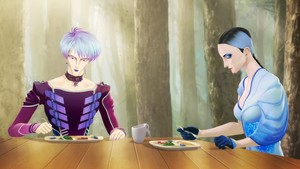 Richard Eisenbeis
Richard Eisenbeis
Rating:
The best science-fiction stories use things like future technology, time travel, and space travel to either teach us something about human nature or force us to confront ethical dilemmas we may never think of normally. Along these lines, Exception's first episode is all about the ethics of cloning technology.
The basic setup is that humanity is set to colonize a new world—and while faster than light travel is possible, living creatures cannot survive the process. Thus, the plan is to send a ship capable of creating human clones (complete with the memories and personalities of the originals) through hyperspace to start the terraforming process while the originals and all the colonists go into cold sleep to make the trip normally. While everything goes to plan at first, a solar flare causes an error in the cloning process of the final crewmember, creating a monster instead of a man. The remaining four clones have to then decide what to do.
This situation allows us to touch on everything from the ethics of euthanasia and whether clones have souls, to the sanctity of life and the personhood of clones versus the originals. That said, the big debate scene of the episode is a bit weaker than it should be because the creature appears to have no consciousness at the time, meaning it is just a husk made from human DNA. Of, course, once it wakes up and starts killing people, things get a lot more complex—both morally and physically.
Going forward, it looks like we have an Alien-style plot where our heroes have to hunt down an intelligent, physically superior creature. This in turn should create all kinds of opportunities to explore the issues touched on in this first episode along with new ones focusing on how these scientists, responsible for thousands of colonists' lives, change when put under this kind of pressure.
Unfortunately, the animation doesn't quite keep up with the story. While the Yoshitaka Amano designs are an awesome touch, the 3DCG doesn't quite do them all justice. There's also what feels like an unnaturally low framerate in certain scenes which makes the animations jump rather than flow. I found it to vary between distracting and headache-inducing.
Overall, I'm intrigued by this first episode of Exception. Despite its animation shortcomings, it has all the markings of a solid sci-fi tale. While I have plenty on my plate at the moment anime-wise, the next time I have a lazy Sunday, I may just queue up the rest of the episodes and see where this story leads.
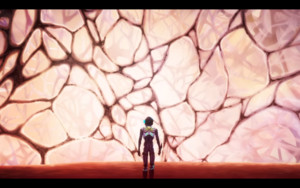 Caitlin Moore
Caitlin Moore
Rating:
There's kind of a funny coincidence here. Just the other day, I was playing Final Fantasy VIII, and my husband mused about how Yoshitaka Amano's designs look like adapted to CG. Lo and behold, a new CG anime with Amano character designs has arrived all fresh and shiny onto my Netflix queue. This one even has much more literal interpretations of his waifish signature style than the Final Fantasy games did.
…With, ah, mixed results I might add. Oh heck, not mixed; they are pretty strange looking across the board. Exception is animated using cell-shaded CG techniques that give it a sort of living painting look, a bit like Arcane but more clumsy and awkward. The result is uncanny and unsettling, but also, I didn't hate it. At the very least, it has a visual identity, unlike approximately three-quarters of anime series that come out these days, and it would have found fellowship in some of the more avant-garde animation ecosystems of the 90s. However, as we have learned well by now, anime fans tend to avoid the avant-garde, so I can't see this going over well.
However, even if the character designs are… unconventional, the mechanical design is lovely. Science fiction can be cold and utilitarian, but Exception proves to be the exception here indeed. Their ship is a giant lionfish swimming through space, its fins kaleidoscopic atmospheric generators. Inside, it brims with art-nouveau ornamentation, with gold scrollwork curving over most surfaces and organic shapes in place of the chill steel and chrome geometry much of sci-fi imagines. Even their spacesuits have a butterfly motif. This design choice speaks to me; stark minimalism is a recent trend, and humans have always been driven to create beauty wherever they can.
What, you want to hear about the plot? It's fine; talking about the nature of humanity, the will to live, etc. Nothing new for science fiction. Execution is solid enough. But honestly, even the most paper-thin plot would be worth sitting through for that ship and Ryuichi Sakamoto's musical score.
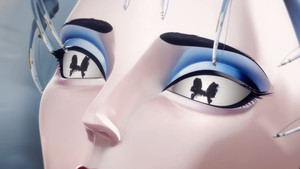 James Beckett
James Beckett
Rating:
I am almost certainly going to be in the minority for enjoying Exception, which I will freely admit is a bizarre and messy attempt at a CGI-animated space horror that most people will understandably write off within the opening minutes of its first episode. This will chiefly be because of its misguided attempt to translate the wispy and ethereal art style of Yoshitaka Amano to 3D, and again, I cannot blame anyone for having that initial reaction. There is a version of Exception that looks more like the straightforward sci-fi horror mashup reflected in the script. I'm imagining something like Alien mixed with Danny Boyle and Alex Garland's Sunshine, as filtered through an early Square Enix film project like Final Fantasy: The Spirits Within or Final Flight of the Osiris. It would probably work pretty well.
And yet I can't help but admire the whacked-out version of Exception that we got, despite (or perhaps because of) its blatant disregard for presenting its audience with a conventionally appealing sense of pacing or visual style. I kind of love that our crew is a bunch of glam-metal-looking 3D-printed clones floating through space inside an insane fish-monster ship and being hunted by a hideous creature that looks like it was ripped straight out of one of Roger Corman's cheaper looking nightmares. I respect the show's ambitions at telling a horror story wherein the crew is literally as expendable as it comes, since they can theoretically be cloned ad infinitum so long as their “biomaterial” remains intact enough to reprocess. I cannot help but be swayed by the small but game English dub cast, especially since our leading scientist Nina is voiced by Ali Hillis, who brought Dr. Liara T'soni and Final Fantasy XIII's Lightning to life—two of my all-time favorite badass space ladies.
I won't pretend that Exception is a great anime so far; I can't even tell you that it's good, exactly. I appreciate it in the way that I've come to appreciate the gonzo Italian giallo films of the 70s and 80s, or truly out-there J-Horror like House. It's ugly, inconsistent, occasionally boring, and its ambitions far exceed its technical capabilities. It's got something, though, some strange spark of weirdness that speaks to me. Maybe I'm just getting sentimental for the Halloween season, but if you're capable of looking past Exception's flaws, it might be worth your time to check out, just in case it vibes with you the same way it did for me.
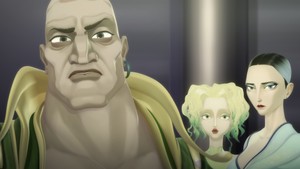 Rebecca Silverman
Rebecca Silverman
Rating:
Exception has its moments – mostly in that it has a concept that has worked in other science fiction/horror hybrids before, as recently as Amie Kaufman and Jay Kristoff's YA series The Aurora Cycle: something goes drastically wrong when humans try to colonize another, distant planet, and that something is at least partially related to attempts to get a human body safely through subspace. In this story, that attempt is a very fancy 3D printer that recreates a human body and implants the consciousness of the original person into it. Done well, it ought to raise questions about what makes someone human and who the “real” person is. Done not so well? You get this.
Even if we ignore the elephant in the room, which is the truly terrifying attempt to translate Yoshitaka Amano's art into CG (I'm not sure who will be staring in my nightmares tonight, Mac or Patty), the writing is pretty bad. Rather than letting us make inferences based on the characters' words and actions, the story takes solemn delight in throwing ham-fisted metaphors at our heads, calling the printer the “womb” and making the discussion between Mac, Nina, Patty, and Oscar sound like sound bites from an abortion debate. And then, after that whole mess, it turns out that it only takes half an hour to “reprint” a human body? That definitely takes a lot of weight away from Patty's argument, but then the writing isn't exactly making her look like a genius, what with that whole bit about her ignoring a directive to stay put because a monstrous Lewis is rampaging around their giant space fish ship.
It is clear that efforts were made to make this interesting and engaging. I will say that I wasn't bored watching it, even if that's not due to it being actually good, and some of the little details, like Nina's shoes, are very nice. There's also the potential for this to turn into a truly horrific time loop story variant, with Nina, Mac, Patty, and Oscar being killed and reborn over and over and over again, forced to relive a hellish cycle. But after this episode I'm not holding out a lot of hope, and think that maybe I ought to just go re-read The Aurora Cycle instead.
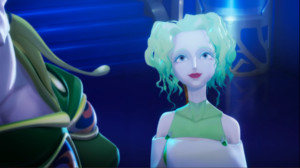 Nicholas Dupree
Nicholas Dupree
Rating:
If you're like me, when you hear Netflix has a new CG sci-fi anime coming out, you roll your eyes and start bracing yourself for how boring it's going to be. If you're not like me, that means you don't have any professional obligation to watch all the boring CG sludge this streaming company has bankrolled over the last five years, and thus the only thing you'll probably ever see from Exception is the trailer showing off the awkward bastardizations of Yoshitaka Amano's art style. And indeed, while there are interesting idea and the potential for a good sci-fi horror story in this premiere, it's all buried under those off-putting visuals.
Look, I don't envy any production tasked with trying to translate Amano's distinctive illustration style into something that needs to move, especially in a modern production pipeline where you have to meet the deadlines of a rapidly capsizing streaming service. That's a game you are destined to lose, and while Exception doesn't look as bad as 2020's Gibiate, it still falls well below looking good. The characters are supposed to be humans – or at least technologically generated human simulacra – but they look positively alien in the way their faces are constructed, falling into an uncanny valley at the exact midpoint between Amano's illustrations and the Star Wars: The Clone Wars cartoon series. It's intensely distracting and, even if you're not put off by it, the character models can barely emote, making the dialogue heavy premiere boring as hell to get through. What's more, this is a horror story, meaning its visuals need to communicate the tension and unease necessary for scares, and that's all but impossible when the most frightening thing on screen is Patty's face.
About the only visuals that aren't a detriment are the environmental designs, which manage a unique marriage of high-tech science fiction with gothic horror and fantasy aesthetics. I don't know why the humans who sent an advance ship of 3D-printed clones to terraform a new planet decided to make the spaceship look like a giant fish, or why they structured the interior like a haunted mansion, but it's at least interesting to look at instead of the characters. The lighting and shading is sadly too flat to complete that package, but staring at the walls is still easier on the eyes than looking at these rigs.
Plus, like I said, there are some neat ideas here. The concept of a monster on a spaceship is tried and true, but making the “monster” an error from the ship's person-printer brings up some interesting questions that the story immediately grapples with. Is this “error” not still a sentient person? Is it ethical to kill it just so they can make a more normal looking clone of their companion instead? If so, what does that say about their own existence as copies full of another person's memories? This episode doesn't delve too deep into it just yet, since it has to set up the larger setting and hook, but it's fertile ground for speculative fiction to grow from, and if this were in a book or a live-action series, I could see myself binge watching it some evening.
But instead we have a misguided animation project that looks like a parody of its own concept art and is fundamentally ill-prepared for communicating the emotions or atmosphere the script is playing with. It's too sterile to truly be horrifying, too clumsy to be the right type of alien, and altogether just begs the question of why it had to be this way.
discuss this in the forum (316 posts) |
this article has been modified since it was originally posted; see change history
back to The Fall 2022 Preview Guide
Season Preview Guide homepage / archives